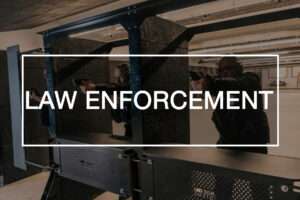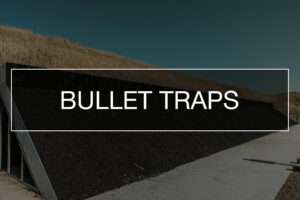Webinar: Top 5 Problems and Solutions With Rubber Bullet Traps
The goal for our September webinar was to provide a clear understanding of the common problems with Rubber Bullet Traps and the solutions to these problems.
[rs-responsive-iframe]
[/rs-responsive-iframe]
What is a Rubber Bullet Trap?
When we say rubber bullet traps we are really talking about two types of traps granular rubber traps and bloc rubber traps.
A granular rubber trap utilizes a thick layer of granulated rubber material, laid on top of ballistic AR500 steel, to safely capture bullets intact with virtually no lead dust or bullet fragmentation while reducing impact noise. This trap allows shooters to advance downrange and engage targets at extremely close distances with no concern of bullet splatter, and is typically used for high volume indoor or outdoor use.
A bloc trap is made of Dura-Bloc™ arranged into a wall and offers a much smaller footprint than the Encapsulator™ Gran Trap. This is ideal for low volume ranges, such as home ranges and forensic ranges.
Problem #1: Rubber Bullet Traps Start on Fire
Clearly starting a fire in your range due to a rubber bullet trap would be a problem. However, by using the proper safety and precautions this issue is very easily preventable. First, I think it’s important to say, Range Systems has been in the range business for fifteen years. During this time we have only seen 3 fires in all ranges we’ve built or supplied.
There are two solutions to this problem. One, don’t use tracer or incendiary type rounds. All three of the fires we’ve seen were because these round types were used.
Two, Maintain your rubber bullet trap. Particularly with Rubber Granular Traps, it’s important to avoid unspent propellant when engaging in close up training. Cleaning out bullet shrapnel on a regular basis is also key with high volume shooting to avoid contact with incoming rounds.
Problem #2: Rounds Go Through Rubber Bullet Trap
The only time we see this being an issue is when there isn’t enough granular fill in the trap, due to either improper filling or cratering. I’ll talk more about this below.

By using a hopper system, which aids in the process of maintaining proper depth, you can make sure there is enough granular fill constantly in your trap.
The second cause of problem #2 is cratering. This is when a physical crater is developed in active shooting spots within the trap. You can avoid this issue by moving testing location within the trap, along with evenly refilling these craters with new granular rubber when one is noticed.
Problem #3: Rubber Bullet Traps Require Too Much Maintenance
A better way to state this problem would be saying, granular rubber traps require more maintenance than a steel trap. When it comes down to it both rubber traps and steel traps require a certain amount of maintenance, the type of maintenance is just different. You need to look at your needs and budget as the user to determine which trap suits you better.
Another note, some range providers offer both steel and rubber traps while some stick to one. Range Systems has the availability to source both types of traps.
Problem #4: Bounce backs and bounce outs in a Rubber Bullet Trap
This is another issue you’ll see with a bullet trap you’ll see. With rubber traps this typically happens when the shooter hits something other than the trap first. The bullet slows down, strikes the trap and then bounces out.
Ways to prevent this are; hanging targets at the correct height as well as use hangers on carriers. By setting up your range correctly, all bullets should exceed the minimum velocity requirements for the trap and enter correctly.
With a properly set-up range you should rarely ever see this being an issue but it important to note wearing proper protection and clothing is a must, and will reduce risk in the rare event this does happen.
Problem #5: Lead Disposal in Rubber Bullet Traps
This is a reality for all range owners no matter what type of trap is used. Lead disposal will always be an aspect of owning a range.
Our best “solution” or advice to solve this problem is to hire professionals to complete the work for you. The majority of companies that provide lead removal services will have plans in place to offset the cost of their services.

They will use a portion of the amount of money they get from recycling the lead, to drive down the cost that you pay for their services.
Key Takeaways
- Recognize all bullet traps require maintenance no matter the type, it’s just a part of this range component.
- Beware of imposter rubber- make sure the rubber you’re buying is tested and certified by a third party and pay attention to its track record with elite groups.
- Engage with shooting range providers sooner rather than later to get important information that will help you make an informed buying decision.
- All rubber bullet trap problems are easily avoidable with proper maintenance and correct use.
Additional Information
You can find additional information on shooting traps, and anything related to ranges at www.nssf.org/ranges. Along with this, check out our blog or webinars section on the site to find other topics we’re discussing. To receive information for our upcoming webinars, subscribe through the webinars section on our site.
If you want to talk with one of our range specialists find the “Contact Us” section of our site to fill out a contact form, or contact a specialist directly through email.
Thanks for reading and we’ll see you on the range!
















